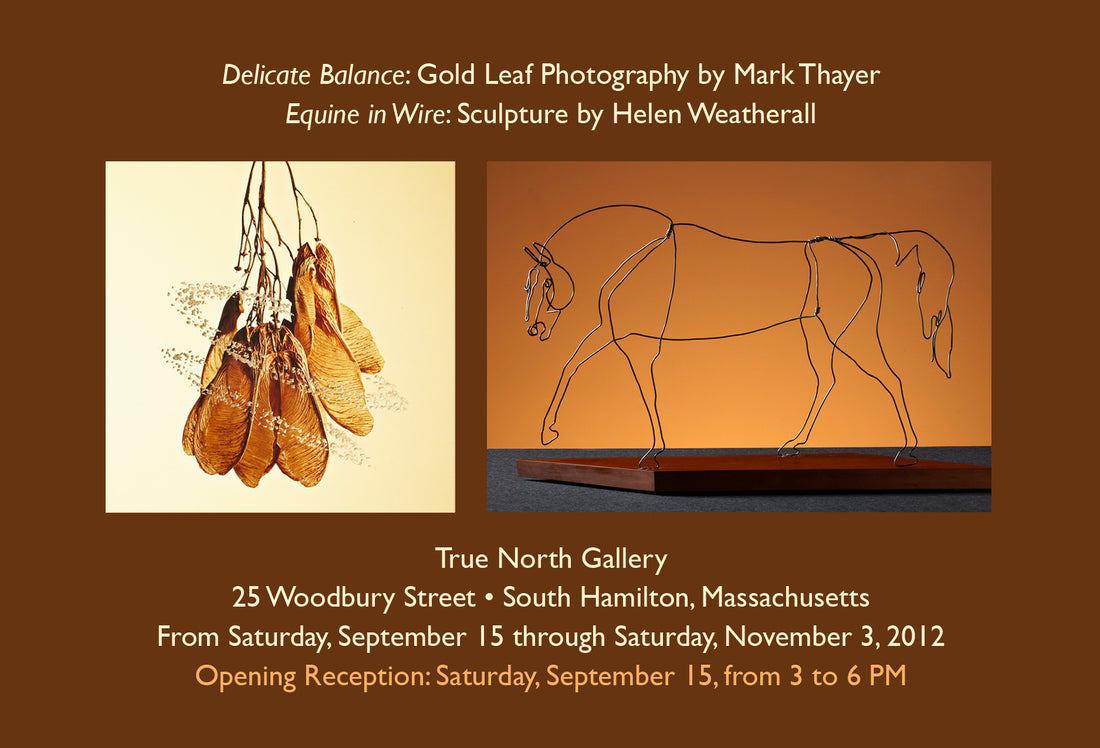From Saturday, September 15 through Saturday, November 3, 2012, True North presents two new shows: “Delicate Balance: Gold Leaf Photography by Mark Thayer” and “Equine in Wire: Sculpture by Helen Weatherall.”
Delicate Balance: Gold Leaf Photography by Mark Thayer
When most mountain bikers are negotiating rocky trails or steep descents, they probably don’t notice a particularly perfect pitch pine sprout or milkweed pod. But when Hamilton, Massachusetts photographer Mark Thayer bikes on the trails throughout Essex County, he not only notices the botanical world he is peddling through, he often stops to collect specimens. The seed pods, stems, leaves, and other plant materials then travel home with him, to his studio, where they become the subjects of his photographs.
Thayer photographs his botanical specimens against neutral backgrounds that he colors by blending different color temperatures of light. His dramatic close-up digital photographs of plant forms are un-manipulated, except for color correction. According to Belinda Recio, owner of True North Gallery, “Through Thayer’s lens, the botanical specimens appear enlivened and possess a numinous quality. We can sense their power. These seeds, pollen spores, and dormant stems aren’t just detritus that nature left behind. Each is a potential forest or meadow, embodying the perpetuation of life itself.”
The ability of a seed or stem to burst forth with new life is what inspired Thayer to start adding gold leaf to his photographs. For Thayer, the symbolism of gold—power, wealth, and resilience—is a perfect reflection of the potential contained within these plant materials. But there is a secondary meaning behind the bursts, orbits, and other patterns of gold leaf that Thayer juxtaposes against his plant images. For him, the gold isn’t just a representation of the plant’s latent abilities, or “wealth,” it is also a reminder to think about our values and what matters most to us.
“As the demands we make on the natural world increase,” Thayer explains, “we find ourselves struggling to find a balance between serving the needs of our species and respecting the needs of so many others. Finding this balance often comes down to a decision about how we define wealth.”
“Thayer’s photographs are provocative in the best possible way,” Recio comments. “They invite us to consider not only the profound potential and beauty of plant forms, but also our place in the world.”
Equine in Wire: Sculpture by Helen Weatherall
Opening at the same time as “Delicate Balance” is Helen Weatherall’s “Equine in Wire.” Weatherall’s wire sculptures of prancing, rearing, and reclining horses reflect the power and grace of her subjects. Weatherall—who lives in Ipswich, Massachusetts—was born with a love of horses that time has only intensified. At present she is retraining an off-the-track thoroughbred named Sally Slew who is both her mount and primary muse. Weatherall’s wire sculptures celebrate the horse in its unbridled and untethered state: A filly primed to race, an Andalusian stallion spinning on its haunches, or a foal learning about legs and gravity. In Weatherall’s work we see the horse as spirit expressed in muscle and motion.
The flexibility and fluidity of wire make it a perfect medium for the horse, whose movements, Weatherall reflects, “can be as subtle as shivering away a fly or as brazen as a kick.” Her sculptures, composed entirely of hand-shaped wire mounted on hardwood bases, capture the kinetic quality of the equine form. Weatherall’s horses give the impression that, if you were to look away, they might buck or gallop off before you return your gaze.
“Working in wire is like drawing in 3-D,” the artist explains. “Wire enables me to describe form as much by what isn’t there as by what is.” According to Belinda Recio, owner of True North Gallery, “Weatherall’s use of negative space invites the viewer to participate in the full realization of her horses, which in turn interiorizes them in our minds. Her wire stallions, mares, and colts have a pure, primal essence that evokes the archetypal horse in our psyches. Through lyrical line and gestural empathy, these sculptures connect our hearts to the horse.”
